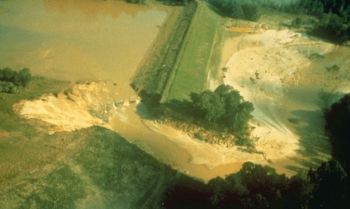Spillway Integrity Analysis

|
| This earth cut, vegetated spillway completely eroded through during a flood resulting in an uncontrolled release of the reservoir. |
Earth-cut auxiliary spillways are excavated through natural soil and/or rock materials, normally protected with vegetation. The Natural Resources Conservation Service (NRCS), formerly the Soil Conservation Service (SCS), assisted local sponsors in constructing more than 29,000 dams throughout the United States, most of which are equipped with an earth-cut auxiliary spillway. Many other dams outside of the NRCS purview have also been constructed with earth-cut spillways. Earth-cut auxiliary spillway geometry typically consists of a trapezoidal open channel with a subcritical inlet, a level crest or control section, and a supercritical exit. Most earth-cut auxiliary spillways were designed more than 50 years ago using general guidelines and engineering judgment without a rigorous analysis of their erodibility for the maximum design storm. Unfortunately, some designs underestimated the erodibility of the spillway. As more and more earth-cut auxiliary spillways are activated, some have performed as designed while others have sustained significant erosion, and several have completely breached.
Recent advances in hydraulic modeling and spillway integrity analysis enable engineers to more effectively identify potential failure modes due to spillway outflows than was previously possible. For example, two- and three-dimensional hydraulic models allow engineers to analyze complex flow patterns for a wide range of flow conditions based on existing or proposed terrain. These analyses can be helpful in identifying areas of high velocity that may be more susceptible to erosion. They can also help engineers assess the impact of downstream features such as road embankments. Detailed hydraulic models can be used to ensure that outflows are directed away from the dam embankment and to estimate anticipated tailwater conditions, including eddies, at the dam during various flooding events.
In addition to these hydraulic models, it is important to understand the geology of spillway outflow channels. Subsurface investigation and testing can be used to define the erodibility of spillway outfalls and also identify underlying geology that could lead to problematic outflow conditions. The NRCS has developed SITES and WinDAM software that include the ability to analyze the integrity of geologic profiles through both earth/rock cut spillways and embankments. These are powerful tools to estimate the magnitude of erosion that would occur during a flood and to identify spillways that may be susceptible to failure should the design flood occur.
Examples
![]() Learn more about earth-cut, vegetated spillway design and integrity analysis (DamFailures.org)
Learn more about earth-cut, vegetated spillway design and integrity analysis (DamFailures.org)
![]() Learn how spillway outflows can adversely impact the dam embankment and operation (DamFailures.org)
Learn how spillway outflows can adversely impact the dam embankment and operation (DamFailures.org)
Best Practices Resources
![]() Technical Release 210-60: Earth Dams and Reservoirs, NRCS
Technical Release 210-60: Earth Dams and Reservoirs, NRCS
![]() National Engineering Handbook: Chapter 50 - Earth Spillway Design, NRCS
National Engineering Handbook: Chapter 50 - Earth Spillway Design, NRCS
![]() National Engineering Handbook: Chapter 51 - Earth Spillway Erosion Model, NRCS
National Engineering Handbook: Chapter 51 - Earth Spillway Erosion Model, NRCS
Trainings
![]() On-Demand Webinar: Introduction to Earth Spillway Design and Evaluation
On-Demand Webinar: Introduction to Earth Spillway Design and Evaluation
![]() On-Demand Webinar: Introduction to Armoring Embankment Dams and Earth-Cut Spillways with ACBs
On-Demand Webinar: Introduction to Armoring Embankment Dams and Earth-Cut Spillways with ACBs
Citations:
Revision ID: 7180
Revision Date: 07/11/2023
